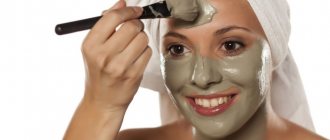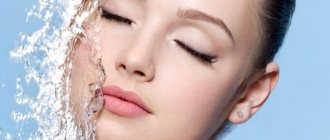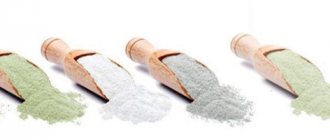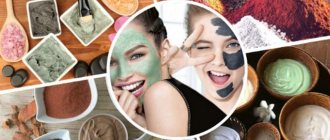Issues discussed in the material:
- Types of cosmetic clay
- 5 rules for using clay masks
- 17 recipes for clay face masks
A person's skin is a reflection of his lifestyle. We live in a dynamic world, and this fast pace of life does not have the best effect on our health. Poor environmental conditions, irregular diet, stress, sleep problems - all these factors affect the condition of our skin. Despite the development of cosmetology, many women prefer to improve their health at home, using natural remedies. One of these is clay.
The benefits of using this valuable product are obvious: it cleanses deeply and carefully, removes dead skin particles from the epithelium, improves skin tone, making it fresher and eliminating inflammation. To achieve a similar effect, you only need to know how to make a clay face mask. This is exactly what we will talk about in our article.
Basic rules for using clay masks
Clay masks can be made from a young age. When used correctly, you can get rid of skin imperfections - cleanse, increase elasticity, and remove the tendency to oiliness. You just need to use the universal product correctly for cosmetic purposes:
- take into account contraindications for the composition of ingredients;
- conduct an allergy test;
- mix the product correctly;
- do not use metal utensils;
- dilute the clay and wash off the mask with warm or cool water, not hot;
- First add the powder, and then add water, milk, broth.
When washing off a clay mask, you do not need to use soap or other hygiene products.
How to use, how it works, how many times a week you can do it
You cannot apply the application arbitrarily, since this is a medicinal product and too frequent procedures can only cause harm.
Cosmetologists recommend using cosmetic clay masks no more than once a week. If the skin is not too sensitive, then the number of procedures can be increased to two. To obtain a positive effect, the procedures should be taken in a course. After 10-12 masks, you need to give the dermis a rest for a while, and then carry out another course.
The application provides not only preliminary preparation of the face, but also subsequent care:
What products can be applied before
Before the procedure, the face should be prepared. You should remove all makeup and wash your face with baby soap or use an alcohol-free lotion. You can make a warm compress on the skin from a decoction of chamomile or celandine.
What products can be applied after
After the mask is washed off and all its components are completely removed, you can apply a light moisturizer to your face. Since masks are usually applied before bedtime, no other products are required.
If your face turns red after using clay
This reaction can be caused by various reasons. This is increased sensitivity to all ingredients of the application, application of the composition to dirty skin or irritation from mechanical particles.
If irritation occurs, you need to do an allergy test, properly prepare your face for the procedure and apply the composition more carefully.
How to store
If the mask includes dairy products or honey, then this composition cannot be stored and the mask is prepared for one time. Clay diluted with water can be stored in a cool place at any time. Simply add warm water to the dried mixture.
Which clay to choose for problem skin
Like any other procedure, doing clay face masks too often is not recommended. In this case, the properties of the powder should be taken into account:
- blue clay is ideal for oily skin;
- red helps improve skin elasticity for older women;
- white clay whitens the face, eliminating age spots;
- green will narrow pores and reduce oiliness;
- black will dry out acne and get rid of oily sheen;
- pink is recommended for dry skin.
Typically, clay powder is diluted with boiled water. But in some cases, you can use milk, herbal decoctions, and glycerin.
How to dilute a mask
In order for the mask to have the maximum positive effect, before preparing it you need to select clay that is suitable for the characteristics and type of skin:
- The white composition (kaolin) is used as an antiseptic. Suitable for sensitive skin.
- Blue clay is used as an anti-inflammatory and antimicrobial agent. The mask is recommended for acne-prone skin.
- Red clay is a remedy against irritation caused by an allergic reaction or dry skin.
- The pink composition, which is a mixture of white and red powder, delicately cleanses and soothes the skin. Recommended as a rejuvenating treatment for aging faces.
- The yellow composition draws out harmful accumulations from the dermis and saturates it with moisture. Recommended for irritated, sagging, wrinkled faces.
- Black clay is a means for deep cleansing of skin pores and normalizing the functioning of the sebaceous glands.
All of the above types of clay are sold in the form of fine powder. To prepare the mask, the powder is diluted to a creamy consistency. It is advisable to take boiled water; you can also use milk, herbal infusions, and glycerin.
It is important to achieve a dense mass, just like sour cream. If the composition turns out to be more liquid, it will flow after application to the face and may get into the eyes. If you make the mass too dense, it will quickly dry out on your face and the procedure will be ineffective. In addition, a quickly drying mask will remove moisture from the dermis, causing a feeling of tightness on the face.
The composition must be thoroughly mixed so that it acquires a uniform consistency. If lumps or abrasives remain in the prepared mass, they can injure the epidermis when applied.
Important! Dilute the clay in ceramic or glass containers. Metal containers cannot be used, as the cosmetic composition may react with the metal.
For facial care, you can use either a monocomponent clay mask or one that includes additional ingredients that enhance the positive effect on the dermis. When preparing a multi-component product, the first step is to dilute the clay with water, and then add other products.
Usually liquid (water, milk, decoction) and clay are taken in a 2:1 ratio. It turns out to be the perfect consistency. However, when diluting, additional ingredients are taken into account.
So, if you plan to include oatmeal or semolina in the composition, then the clay powder needs to be diluted with a little more liquid, since the solid components will swell. And if you want to make oil or juice into a useful ingredient, then you need less water.
What to consider when choosing clay face masks
It is important to apply a clay mask to your face correctly, regardless of what type of clay is being used at the moment. Before the procedure, it is advisable to take a herbal bath. A prerequisite is to remove makeup.
Immediately before applying the clay, you should wash your face with warm water to open the pores and better absorb the beneficial substance. The area around the eyes should be treated with cosmetic oil.
After applying the clay mask to your face, lie down and relax. It is not advisable to walk around with a mask. If itching or burning occurs, immediately wash the clay off your face.
To enhance the effect, the composition can be enriched with oils, herbal extracts, and fermented milk products.
Alginate masks
An alginate mask is the most confusing and inconvenient to use on your own. But many are ready to put up with difficulties, because such masks give a quick lifting effect and sculpt the oval of the face. Most often, an alginate mask is presented in the form of a powder, which must be diluted with water or serum in the kit and applied to the face as quickly as possible, before the substance has time to harden. Such masks are modeling, that is, they tighten the skin and fix it in this state for some time. They need to be applied in a horizontal position, with the head slightly thrown back, in order to restore clearer contours of the lower third of the face. This is especially true for those who have already formed marionette wrinkles from the corners of the lips to the lower part of the cheekbones.
Alginate mask Dermask Shaking Rubber Elastic Shot Dr. Jart+
970 ₽
Alginate face mask Colorful “Charcoal” Sephora
199 ₽
Renewing alginate face mask with papaya, arginine and hibiscus Skin Needs L'Etoile
212 ₽
Considering that when applied, the alginate mask is quite liquid and drips off the face, making it yourself, and even while lying down, is quite inconvenient. I advise you to save such masks for evenings with girlfriends and act as cosmetologists for each other. Alginate masks can be applied to the entire face, including the lips and the area around the eyes, but be careful: for some, a continuous application may trigger an attack of panic or claustrophobia. Before applying the mask, cosmetologists advise using a serum that suits your skin type. This way the components of the product will act with double force, and the effect will be more pronounced. The alginate mask is removed in one movement from bottom to top.
Types of cosmetic clay
If you apply a clay mask correctly, you can achieve a positive effect. But for this you should take into account the types of clay:
- kaolin (white clay) promotes a lifting effect;
- keel (blue) has antiseptic properties;
- illite (green) contains zinc;
- yellow helps improve blood circulation;
- pelagic (red) enriches capillaries with copper, manganese, iron;
- pink has a beneficial effect on sensitive and thin skin;
- black contains iron, calcium and quartz, promoting cell regeneration.
Cream masks
Cream masks are the least demanding of all. It's hard to make a mistake with them, and even if you leave them on your face too long, nothing bad will happen. Many of these masks do not need to be washed off at all - just remove any remaining residue that has not been absorbed with a damp cloth. It is best to apply cream masks while you are taking a bath. Take your time, lie down for 10 minutes and only then begin the procedure. The heat and steam will open the pores of the skin and allow the ingredients from the mask to penetrate deeper. Unlike clay masks, cream masks do not need to be applied in a thick layer, especially if they are moisturizing or nourishing. The skin will still not be able to absorb a large amount of the product, and it will be wasted.
Cream mask Anti-Stress Cellcosmet
11 500 ₽
Multifunctional restoring and moisturizing face mask Hydra Beauty Camellia Repair Mask Chanel
4 700 ₽
Soothing face mask Natural Beauty Organic Kitchen
357 ₽
Cosmetic clay: how to use for face and body
Before using the adsorbent, you should understand not only the question of how often you can apply clay to your face, but also how to use it correctly at home.
Those who want to master clay procedures to perfection and start making money from them are recommended to undergo training as a cosmetologist from scratch in Voronezh https://voronezh.ecolespb.ru/cosmetology-school/upkeep here or at any other training center in this specialization.
There should be no difficulties in applying the mask. The clay is diluted with cool water. If necessary, other beneficial substances are added. Apply the mixture onto the face with a brush, excluding the areas around the eyes and mouth. The layer should be quite thick. As the base dries, it is moistened with water. Remove the mask with regular, non-hot water. If there is a feeling of tightness, applying a nourishing cream is allowed.
How to cook properly
The positive factor of clay as a cosmetic product is that masks from it can be prepared and used at home. To prepare the mask, fine clay powder must be diluted to the consistency of sour cream. For this purpose, distilled or boiled water can be used, but most often, the cosmetic composition is prepared using decoctions of medicinal herbs, dairy products or honey. In some recipes, the powder is diluted with glycerin.
When preparing a mask at home, you need to thoroughly mix all the components included in the composition so that the finished mixture is a homogeneous mass. It should not contain lumps or hard abrasive particles that can damage the skin when applying the composition to the face.
You need to monitor the consistency of the resulting composition. If the mixture is too thick, it will harden quickly and the beneficial substances will not have time to be absorbed into the skin, and the liquid mixture will simply drain after application.
You should not use metal utensils when making a cosmetic mask. Containers made of glass, earthenware or porcelain are best suited for this purpose.
How to apply a mask correctly
To achieve the desired effect, you should adhere to the following rules:
- Before the procedure, remove makeup with alcohol-free lotion;
- cleanse the skin by washing;
- steam your face and open the pores with hot water or chamomile infusion;
- leave areas around the eyelids open;
- Apply the clay in a thick layer with a special cosmetic stick.
Some people prefer to spread the mixture over their face with their fingers. In this case, hands should be washed thoroughly.
If you are individually intolerant to the components, you cannot make a clay mask.
Mask exposure time
You should not keep a clay mask for a long time, because when it dries, it begins to tighten the epidermis.
How long you should keep a mask made of any clay on your face depends on the type of epidermis:
- if the skin is dry, then the composition should be on the face for no longer than 5 minutes;
- if the cover is normal or combined, then the optimal time is 10 minutes;
- if the epidermis is oily, then the desired time is 15–20 minutes.
Attention! To prevent the clay from turning into a tightening crust on the face, it should be periodically sprayed with water from a spray bottle.
How to shoot
An important point is the question of how to remove the clay mask from the face. This is done using warm water or by wiping the skin with a damp cotton swab. In this case, gels, foams and any other hygiene products are not used.
Those with dry skin will have to additionally apply a tonic or chamomile decoction to their face, then lubricate it with a nourishing cream.
For normal and oily skin, such actions should be performed only if there is a feeling of tightness. Usually, if there are oils in the mask, such unpleasant consequences do not happen.
Choosing clay for different skin types
- White clay or kaolin is a “soft option” that is most often used in Korean masks for problematic and oily skin. The benefits of a white clay mask cannot be overestimated. This component carefully cleanses and absorbs sebum and softens even the most sensitive skin. Oily skin will also like kaolin due to its anti-inflammatory and healing effect.
- The famous ghassoul clay , which is obtained in Morocco, nourishes, saturates with valuable minerals and trace elements, reduces inflammation and heals the skin. It is a mask with Moroccan volcanic clay for the face that best moisturizes the skin, because gassoul can retain a large amount of moisture. Clay softens even very dry, tired skin.
- Pink clay will soothe your dry and sensitive skin, relieve irritation and flaking. And for aging skin it will prevent the appearance of wrinkles.
- Blue clay is great for normal to combination skin. Blue clay face masks help get rid of acne and cleanse, as well as nourish and tone the epidermis.
- Green clay also takes care of skin susceptible to age-related changes, restoring its softness and elasticity. It also maintains an optimal level of moisture and, thanks to its powerful antibacterial properties, cleanses pores, treats acne and relieves redness.
Soothing clay mask with green tea. 75 ml, RUB 2,150
Facial clay: composition and use in home cosmetology
At its core, clay is a sedimentary rock with a fine-grained structure. When dry, it is as fine as dust. When moistened, it becomes plastic and takes any shape.
The clay composition contains silicon, aluminum, quartz, and iron. Moreover, it depends on the place of extraction. The colors of clay are also different and depend on the chemical composition.
In cosmetology, facial clay is used depending on the color for different skin types. The list of beneficial effects of clay on the skin is quite long:
- It has antioxidant properties
- Restores skin cells
- Rejuvenates and strengthens
- Smoothes wrinkles
- Cleanses and tones
- Evens out color and structure
- Gently removes dead cells
Oxygen (bubble) masks
But oxygen masks that form cheerful bubbles are suitable for everyone without exception. They are especially recommended for residents of large cities, because they remove dust, dirt, smog microparticles and benzopyrene toxins from the skin, which settle on it during the day. Poor ecology has a destructive effect on the skin, causing increased sensitivity, irritation, dryness and flaking. Oxygen masks have a detox effect, healing the skin. In addition, during their use, micromassage of the face occurs and blood circulation is stimulated. This improves complexion and makes skin fresh.
Bubble Sheet GlamGlow Face Mask
890 ₽
Carbonated Bubble Clay Mask BioAqua
950 ₽
Double mask with pink and black clay for combination skin My Orchard TU Drawing Mask FRUDIA
160 ₽
The bubble mask is applied in a thin layer to dry skin and left for about 5–10 minutes. This time is quite enough to slightly enhance microcirculation, ensure an impact on the intercellular environment and utilize cell waste products. Oxygen masks should not be applied to the area around the eyes and lips, and they should not be rubbed into the skin. In general, that's it, there are no more rules.
Bottom line.
Not a single mask - neither cream, nor fabric, nor alginate, nor bubble - is a replacement for face cream. It is required after using any mask, as it seals all the active substances in the skin until the pores close, thus making the effect of the mask more pronounced and prolonged. A mask is just one step in the skin care system - along with cleansing, exfoliating, toning and moisturizing. Each of these stages is equally important and necessary.
Popular recipes for masks with white clay at home
The popularity of masks with white clay at home is explained by the ease of their preparation and the excellent effect of their use. They do not take much time, and the result will not be long in coming.
What are the most popular masks among women today? Firstly, a standard mask with clay, milk and starch, and secondly, masks with the addition of various products. This can be honey, lemon juice, and also calendula, which gives a good antiseptic effect. The addition of string, cabbage leaf, and sea buckthorn oil will cleanse the skin.
There are a huge number of mask recipes, so you can choose those that you like best and add those components that are available in the refrigerator or home medicine cabinet.
To prepare a face mask according to the classic recipe, you need to take white clay, which is also popularly called porcelain clay, because of the pure and radiant color of this substance.
Method of preparation: white clay purchased at the pharmacy should be diluted in lukewarm water and applied to the face for 8-10 minutes. After this, rinse with water and apply moisturizer to the skin. Instead of water, clay can be diluted in milk or herbal decoction.
What effect will we get: whitening, getting rid of oily shine and cleansing the skin.
A white clay face mask can also have an anti-inflammatory effect. Dermatologists usually talk about the benefits of black, green and blue clay, but porcelain (white) clay can also remove redness and acne on the skin.
We buy all the ingredients at the nearest pharmacy and then mix them in the following sequence:
- Take 10 grams of dried linden and nettle and pour boiling water over it. Let it sit for 30 minutes.
- The resulting herbal infusion needs to be filtered and cooled slightly until it becomes lukewarm.
- Pour the herbal decoction into a glass container and add 30 grams of vitamin E.
- Add 20 grams of kaolin and mix thoroughly.
- Apply the prepared porridge for 20 minutes and then rinse thoroughly.
To cleanse your face well with white clay, you need to know a few secrets:
- You need to first open the pores on your face using steam herbal baths. Chamomile and sage work best. Or just wash with hot water.
- Apply the mask only to clean skin.
- Before using the mask, apply a scrub to your face to remove dead cells.
- After washing off the mask, you need to close the pores: apply any moisturizer to them.
Remember that deep cleaning should be done no more than once a week. This can be done not only in the salon, but also at home.
For example, with this remedy: Mix a spoonful of clay with miramistin and chlorhexidine and stir into a paste until smooth. Apply this composition for no more than 20 minutes.
A white clay mask is ideal for whitening your face. You can achieve the maximum effect and lighten your skin by 2 tones by adding fruit and vegetable juice to the composition. The most popular and effective are cucumber or lemon juice. With this product you can not only cleanse and moisturize the skin, but also relieve inflammation and irritation.
How to cook:
- take several large cucumbers;
- grate or extract juice from them;
- mix with two tablespoons of white clay;
- spread on face and leave for 15 minutes;
- Wash thoroughly after use.
The prepared mask can be stored in the refrigerator for 8 hours. Suitable for all skin types. And instead of tap water, you can use mineral water when rinsing off, which will create an additional tonic effect.
To obtain a rejuvenating effect, you can dilute white clay in milk. It is not for nothing that the beauty recipe of Queen Cleopatra, who, according to legend, loved to take milk baths, has survived to this day. It is milk that rejuvenates both the body and facial skin.
We invite you to familiarize yourself with Honey for the face in the bath: benefits
A mask with white clay and egg gives an excellent rejuvenating effect.
Aloe juice, which can increase the vital activity of cells, will also help give the skin a rejuvenating effect. The popularity of this recipe is also explained by the fact that this plant grows in many homes, or on the windowsills of beloved grandmothers.
Aloe leaves must first be cut, washed well and put in the refrigerator. Ideally, they will lie there for 10-14 days.
It is better to choose thick and fleshy leaves; more juice and pulp can be extracted from them. Why put them in the refrigerator? Yes, simply under the influence of low temperatures and darkness, aloe will produce special biological stimulants, which will give the effect of skin rejuvenation.
Then everything is simple - you need to mix the juice and pulp extracted from the flower with white clay, and after 20 minutes enjoy the result.
There is such an interesting recipe with the addition of tea tree extract.
You need to take a tablespoon of clay and half a teaspoon of salicylic acid. Next, you need to pour in tea tree essential oil (3-4 drops, no more!) and 3 tablespoons of water. You can use boiled or mineral water.
To properly prepare the mask, first mix clay and salicylic acid. Next, add the oil and rub in a ceramic container until the lumps disappear. Water should be added last.
Naturally, you must first remove makeup from your face and cleanse your skin. The maximum time for which the mask can be applied is 20 minutes. However, the first time you use it, it is better to cut it in half. It is recommended to carry out the procedure no more than 2-3 times a week.
Adding lemon juice to masks gives them a whitening effect and even smoothes out annoying wrinkles.
To prepare the mask you need:
- Take white clay and one small lemon.
- Press 3 drops of lemon juice into the prepared container and add 1.5 tablespoons of clay.
- Add a little water and dilute the resulting mixture to a paste.
- You can use a mask.
The approximate time for which you need to keep this whitening mask is 10-11 minutes. It is better to wash it off with slightly cool water. You can add gruel of finely grated cucumber to the mask. This component will refresh the skin and also give it a whitening effect. Cosmetologists recommend making such a mask once every 3 days.
A white clay face mask can also be added with fresh milk. The product can be either homemade or store-bought, pasteurized. This product will help rejuvenate the skin, get rid of dryness and improve its condition. Therefore, this mask is well suited for dry skin types.
After use, the skin will receive gentle hydration and additional nutrition, and the signs of aging will disappear for a long time.
Making this mask at home is easy and simple:
- Take three spoons of cow or goat milk.
- Add a tablespoon of homemade cottage cheese or sour cream.
- Mix the dairy products thoroughly with a tablespoon of white clay.
- You can apply the paste to your face for 20 minutes.
The product can remove excess wrinkles and age spots, tightens the skin well and gives it freshness. For preparation you only need honey and clay.
Cooking method:
- Heat a teaspoon of bee honey in a water bath until the honey becomes completely liquid.
- Add a tablespoon of clay, pouring it into the honey in small portions.
- The mixture must be brought to a creamy consistency.
- We wait until the mask cools down a little so as not to burn your face, and then apply it for 20 minutes.
This mask is suitable for women with oily skin. Another variation could be a mask made of honey, kefir and clay. The preparation method is the same, you just need to add a little kefir or whey to the composition.
An interesting option for a mask that is suitable for dry skin types is milk, honey, clay and a couple of drops of almond oil.
By enriching your facial care product with essential oils, you can create a real spa at home. By choosing the right components, it is easy to clean pores, remove inflammation, or, conversely, moisturize the skin.
To make a clay mask with added oil you need:
- Mix all components (except kaolin) in the selected container.
- After this, add the liquid ingredients to the clay and stir until the lumps disappear.
- Apply to skin.
The base liquid can be boiled water, juice, yogurt or herbal decoction. It is advisable to use a mask with the addition of essential oil immediately after preparing it. But if the need arises, it can be stored in the refrigerator for up to 2 days, tightly closing the container.
How to make face masks with clay correctly
Clay is neutral in composition and, thanks to this, has virtually no contraindications. You cannot make masks with it for inflammatory skin processes or general malaise.
Cosmetic clay for the face is sold in powder and for a mask it is diluted with water to the consistency of sour cream. The water used is clean, without gas.
To enhance the effect of the mask, honey, oils, herbal decoctions and other ingredients are added to it.
Film masks
Expert opinion
Irina Babakhova, expert cosmetologist and head of the coaching group “Film masks act quite aggressively, so I would not recommend getting carried away with them.
All such masks contain alcohol in a fairly high concentration (about 10%). It cannot be excluded from the composition, since it is a stabilizer and keeps the film mask in a gel-like state until it is applied to the skin. Alcohol is bad for dry and aging skin, and can cause severe irritation on sensitive skin.” Film masks are only recommended for those with thick and fairly young skin with enlarged pores and excessive oiliness. They exfoliate the layer of dead cells from the surface of the skin, cleanse pores and give a matte appearance. However, they cannot be used if the skin is inflamed or its surface layer is damaged. In general, this is a rather controversial product, to which there are many gentler alternatives, such as soft peelings.
Waso Film Mask “Cleansing and Renewal” Shiseido
2 950 ₽
Boscia face film mask
2 650 ₽
Facial mask against blackheads Good Skincare Sephora
660 ₽
Indications and contraindications for white clay masks
It is advisable to use white clay in the following cases:
- acne on the face;
- black dots;
- inflamed facial skin;
- age-related changes - facial wrinkles, age spots, other signs of premature aging;
- violation of the secretion of the sebaceous glands.
There are no contraindications to the use of kaolin, since it is a natural material. Clay is absolutely safe for humans and cannot cause harm to health. When choosing to use store-bought masks based on white clay, carefully look at what else is included in the composition. Many substances, such as honey and nuts, can cause an allergic reaction.
It is strictly forbidden to apply clay if there is damage to the skin - wounds, scratches. This can cause itching and irritation and lead to inflammation. To test your skin's sensitivity to the product, apply a small amount to the crook of your elbow.
Remember that women with dry sensitive skin should not overexpose the mask. You can’t wait until the clay completely dries or the time according to the instructions runs out.
All clay masks are applied to previously cleansed skin!
And here we are not talking about decorative cosmetics, but about sebum, which prevents trace element ions from reaching the skin. Fat repels water, and therefore repels ions dissolved in it.
To prevent this from happening, it is advisable to carefully degrease the skin. “Neatly” is the key word here. You shouldn’t run for acetone, but a soft surfactant in foam or gel will be just right.
At this point, a question is often asked: is it necessary to blot the skin with a towel? Slightly. The skin should be slightly moist, not dry, but it should not run down your face.
Benefits of clay for the face
Cosmetic clay has a porous structure, due to which it absorbs sebum and impurities. Deeply and carefully cleanses, removes dead skin cells, makes the complexion look fresher, and eliminates inflammation.
Any type of clay has these properties, but there are differences. They are due to the fact that different microelements predominate in them. This is also the reason why clay can be multi-colored.
- White Due to the fact that it is based on a mineral called “kaolinite,” white clay is often called kaolin. One of its properties is skin whitening. Homemade white clay face masks help even out your complexion and make freckles less pronounced. Its ability to narrow pores and provide a lifting effect is also valued. At the same time, it is an excellent absorbent and a good antiseptic.
- Blue It is mined in Bulgaria and Crimea. The clay has a bluish tint due to the fact that it contains silver. Thanks to this, it has a pronounced antiseptic effect. Therefore, masks based on it are recommended for acne. Improves cellular metabolism, due to which it has a rejuvenating effect.
- Green Recommended for mature skin. Smoothes wrinkles, increases the firmness of the dermis and its elasticity. Thanks to zinc, it has pronounced antiseptic properties, mattifies the skin, and dries out inflammation.
- Yellow Famous for its ability to remove toxins. Improves blood circulation, saturates epithelial cells with oxygen. Tones the skin. Suitable for caring for aging skin.
- Red Contains microelements (iron, copper, manganese), which improve the condition of capillaries and saturate the epithelium with oxygen. Suitable for sensitive skin.
- Pink Combines the properties of white and red clay. Also suitable for the care of delicate skin.
- Black Contains quartz, calcium, iron. Stimulates blood circulation and metabolic processes. Helps get rid of toxins, fat deposits, accelerates regeneration. Helps restore a clear facial contour.
The importance of following all the rules
The final result largely depends on compliance with the rules for using clay. It should be understood that although clay is a natural component and extremely rarely causes allergic reactions, if improperly diluted, applied to the skin or hair, or washed off, it can cause irritation, redness, itching and other problems.
Due to its composition, any clay acquires the ability to absorb substances from the environment. Therefore, the most important recommendation would be to purchase clay of the best quality. You should not choose masks or dry compositions for dilution with liquid from a cheap price category. It is likely that such clay was mined in areas located near factories (hence, it has absorbed harmful substances) or that its useful life is nearing its end (if there are any useful vitamins and microelements left in it, there are very few of them). Choose products from trusted manufacturers. The shelf life should not exceed more than a year. It is best to use clay a few months after it has been mined and packaged.
After purchasing a quality product, you should make the most effective and harmless composition. Of course, if we are talking about ready-made masks, then you don’t need to do this yourself - the manufacturer has provided for everything. But if you buy clay in jars or bags, that is, in dry form, then you need to learn how to dilute it correctly.
For this purpose use:
- mineral water without gas;
- liquid sour cream;
- cucumber juice;
- sauerkraut juice;
- infusions of medicinal herbs, in particular chamomile, lemon balm, mint;
- olive oil;
- essential oils.
The consistency of the diluted clay should resemble sour cream with 20 percent fat content. If the composition is thicker, the clay will clump and dry out the skin greatly. Rare consistency will not show effectiveness.
It is important to choose the right type of clay. There is a lot of information about this, in addition, on each package it is written what problems a certain type of powder will relieve.
Cleansing masks based on different types of clay
Once you have decided on the color of the powder, you can safely apply it to your face as a mask. For maximum effect, clay can be combined with other natural ingredients. You should first make sure the additional ingredients are fresh.
Scrub mask made of black clay and fresh lemon juice
Mix black clay in the amount of 2 tablespoons with calendula tincture (2 tablespoons), pour in freshly squeezed lemon juice (1 teaspoon). Mix all ingredients to a porridge consistency. The mixture is evenly distributed over cleansed facial skin. The mask simultaneously functions as a scrub.
Blue clay to restore complexion
It will help eliminate spots on the face and whiten the skin. For the mask you will need 2 tablespoons of clay, then add 1 tablespoon of sour milk and fresh tomato juice. The product is great for removing acne marks.
White clay to combat age spots
A combination of white clay and badyagi will help get rid of pigment spots that are unpleasant to the eye on the face. This truly amazing cocktail can work wonders. 1 teaspoon of badyagi is mixed with 2 teaspoons of kaolin and placed on the face with gentle movements.
Green Clay Cleanser
To create an emerald cleansing mask you will need green clay, dry yeast and fresh cucumber. Yeast (2 teaspoons) and clay (4 teaspoons) are mixed with cucumber crushed to a pulp. The mixture is distributed over the face and after a while removed with warm water. This mask option is universal because it is suitable for all skin types.
Gray clay - moisturizing component
Gray clay (1 tablespoon) is mixed with cocoa and almond butter (1 teaspoon of each component). The mixture is applied to the face with gentle movements. This moisturizing and at the same time cleansing gray clay mask is a godsend for dry skin.
Toning mask with yellow clay
Combine a tablespoon of yellow clay with egg yolk. Next add 1 teaspoon of sea buckthorn oil. Mix everything and apply the resulting mixture to your face.
Skin-soothing red clay mixture
Combine red clay and cream (2 tablespoons of each ingredient) with 2 teaspoons of aloe juice. The mixed components are applied to the face with stroking movements.











